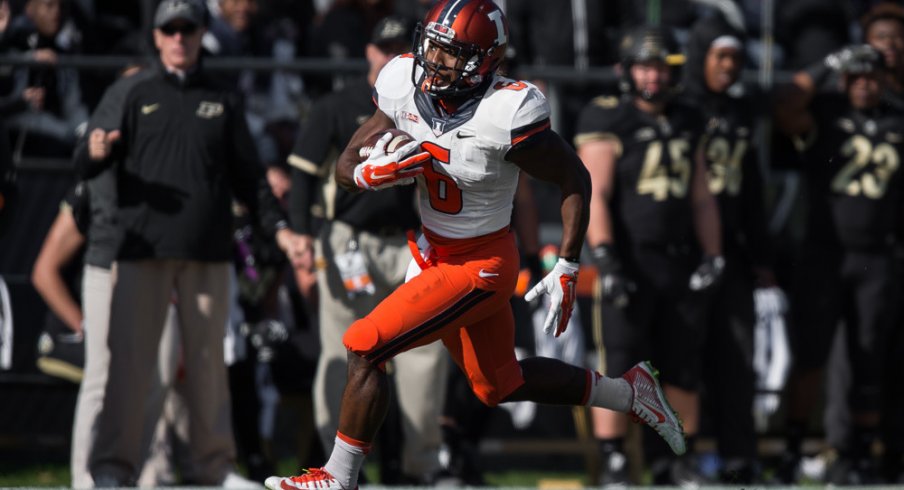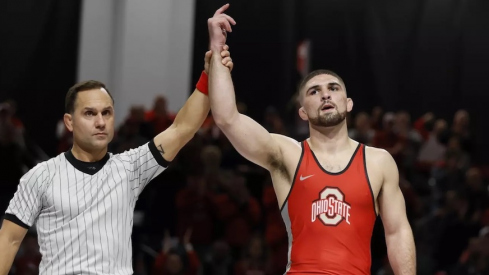After a tumultuous offseason that saw the firing of head coach Tim Beckman for allegedly pressuring players to play through and delay treatment of injuries, interim head coach Bill Cubit has done a remarkable job steadying the ship and putting the Illinois Fighting Illini in position for bowl eligibility.
The team's 2015 season has been a story of hot and cold streaks, starting the season by winning four of five games and the lone blemish coming against an 8-1, 16th-ranked North Carolina squad. But after losing key running back Josh Ferguson (A member of the 2015 Doak Walker Award Preseason Watch List) to a shoulder injury early in a 14-13 win over Nebraska, Illinois proceeded to drop three straight contests before thrashing Purdue in his return. The senior running back picked up right where he left off, gaining 174 all-purpose yards and scoring one touchdown on limited carries.
Currently sitting at 5-4 with bowl eligibility on the line, the Fighting Illini face a tough three-game stretch to close the season, starting with their home finale against Ohio State this Saturday. They finish the season with consecutive road games against Minnesota and Northwestern, no easy task in November when running the ball often becomes a necessity due to weather conditions. With memories of last season’s 55-14 drubbing in Columbus, potential bowl eligibility, and a ten-game home losing streak to the Buckeyes, Illinois has ample motivation to pull off the upset. To keep pace with an offense that has seemingly found its rhythm under J.T. Barrett, the Fighting Illini need a Herculean effort from the versatile Ferguson on the ground and through the air.
Although Ferguson is not large (5-9/200) for a running back, he is a willing inside runner that consistently creates yards after contact. In a 48-14 victory over Purdue the deceptively strong running back continuously gashed the Boilermakers with Power and Counter, showing off his excellent vision, anticipation, and feet.


Ferguson displays an uncanny ability to read blocks as they develop, showing patience before exploding to the end zone as he did on the Buck Sweep against Kent State.

As valuable as Ferguson is to the Illinois ground game, he truly differentiates himself from other running backs through his outstanding ability to catch passes out of the backfield.
The often-overlooked Ferguson is one of only four active Division I players to achieve 2,000 career rushing yards and 1,000 career receiving yards. He has two 50-reception seasons, reaching the mark during both his sophomore and junior years. However, Ferguson is more than a volume receiver, demonstrating the ability to turn a 5-yard pass into a 50-yard touchdown as demonstrated by his eight career touchdown receptions. Ferguson’s versatility as a pass catcher is noteworthy; his touches will come off designed passes, check-down routes, jet motion, and even from the line of scrimmage, where he will align as a slot wide receiver.
Much like the 2015 Buckeye offense has utilized Ezekiel Elliot to attack the perimeter as opponents load up to stop the inside run game, the Illinois offense will target Ferguson with designed Flare screens out of the backfield.

The philosophy behind the Flare screen is simple: outnumber the perimeter defense (remember football is a numbers game) and quickly get the ball to a playmaker in the open field. By forcing the defense to scheme for Ferguson’s pass-catching ability, the Illinois offense is able to manipulate defenders out of the box, creating opportunities for their zone and gap-based running game.


Ferguson displays outstanding ability to read and react off his open field blocks, as he weaves through traffic and presses north-south at the first site of a running lane. Many running backs make the mistake of pressing screens upfield too quickly, overrunning their blockers and leaving yards on the field. Not Ferguson, as his patience and vision allow his wide receivers and offensive linemen to get downfield to their blocking fits.
The Fighting Illini offense will also attack the perimeter and slow down an aggressive defensive line by using Ferguson in the traditional halfback-screen game.

The mechanics of a halfback-screen are fairly simple. The outside receivers will often (but not always) run clear-out routes, running the defenders away from the play. The pulling offensive linemen must block for a few seconds to sell the screen, before releasing the pass-rusher and heading upfield. Blocking rules and assignments will vary by offensive scheme and defensive front, although a good rule of thumb is to block inside-to-out (block the first defender who threatens to cross the face).
If executed correctly, the running back will receive the ball near the line of scrimmage with two or three blockers walling off part of the field.

In the example above, the tight end runs a clear-out route to eliminate the middle linebacker (MIKE), while the wide receiver stalk blocks the weakside linebacker (WILL). The center, guard, and tackle move upfield looking for unblocked defenders (known in coaching circles as “looking for work”). Ferguson does the rest, reading his blocks and taking it in for six.
The Illinois offense will take the halfback screen a step further, running the concept off play action. The unit ran the play successfully in last year’s OSU-Illinois matchup, picking up a solid gain here on second down to set up a manageable third-and-four.

Notice Ferguson’s natural pass catching ability and soft hands. Although the throw is high due to interior pressure, Ferguson effortlessly plucks the ball out of the air and gains an extra three yards after first contact. A less-skilled running back is not making this play, forcing the offense into an obvious third-and-long passing situation.
Ferguson’s route tree is not limited to flats, flares, and screens. During the 2014 season, current head coach and former offensive coordinator Bill Cubit dialed up a beautiful concept attacking a MOFO (middle of the field open) coverage shell, forcing the MIKE to mirror Ferguson with predictable results.

With the defense playing a Cover 2 shell, Cubit dialed up mirrored Smash routes. Notice how the corner routes by the slot receivers force both safeties off their hash towards the sideline, widening the middle hole Ferguson is aiming for. Ferguson runs a great route, avoiding the MIKE’s jam and bending back inside away from traffic.
To create plus personnel matchups and expand Ferguson’s route tree even further, the running back will often line up as a slot wide receiver on passing downs. From this alignment the offense will utilize a variety of concepts to get the ball in his hands.


Although not considered a burner, Ferguson is able to win both plays, taking the edge on the jet sweep and beating the safety in man coverage on a Switch concept.
What does Ferguson’s versatile skill set mean for the Ohio State defense this Saturday? Where are the stress points?

As Eleven Warriors has previously documented, Ohio State’s base coverage shell is a pattern-matching Cover 4. While Vonn Bell and Tyvis Powell will generally match-up with Ferguson when he aligns as a slot, the bulk of the coverage work will fall upon the linebacker unit.
In the Chris Ash Cover 4, the SAM and WILL cover the curl/flat zones, an area of the field approximately outside the hash marks to the sidelines. The MIKE is responsible for the seam and middle hook.

Although landmarks and specific technique will vary by coach, the curl/flat defender should start his drop by opening the hips to the near sideline to gain width and depth. He will alternate the eyes between the quarterback and receiver to identify any threats to his zone. If an offensive player does threaten the defender’s zone, he will widen with the receiver, ensuring that outside leverage is maintained on the offensive player.




Notice how the linebacker opens his hips to the sideline and doesn’t break on the route in both clips. Curl/flat defenders ALWAYS break on the ball, as a sound drop will put the defender in position to break up the pass or make a tackle for minimal gain.
The MIKE is responsible for the seam/hook zone, a difficult task as he must play both shallow crosses and carry any vertical routes by receivers out of the backfield. As the MIKE is often the least athletic linebacker on the field, smart offenses will look for ways to isolate him against skill position players.

Communication and eye discipline are vital to covering the hook/seam zone. Defenders will alert the MIKE to any shallow crosses, but he must use his eyes to identify any threats running down the middle of the field. If a threat does show up, the MIKE should reroute the receiver and carry him downfield.

Notice how quickly Cam Williams identifies the running back as a vertical threat, walls off his route, and flips his hips to carry the route through the back of the end zone. That’s great recognition and technique.
The Illinois offense has utilized Josh Ferguson’s talents in creative ways throughout the 2015 season. Anticipate the trend to continue this Saturday as they use Ferguson’s pass-catching ability to stress the underneath zones, a weak area in Ohio State’s base Cover 4. In addition, Bill Cubit is outstanding at finding and exploiting personnel mismatches with his flexible running back; expect him to spread the field and take a vertical shot down the middle at the MIKE.
While the game certainly looks like a mismatch on paper, a dual-threat player of Josh Ferguson’s caliber can be an X-factor. Yet we also know the Ohio State linebacker corps relishes the challenge of stopping a premier player like him. Will the winner of this matchup foretell the winner of the game? We’ll find out on what looks to be a perfect fall afternoon for football this Saturday.


